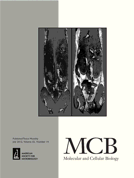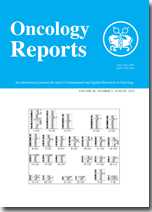Mol Cancer Res:SDF-1/CXCR4信号轴与乳腺癌转移密切相关
2012-07-13 Beyond 生物谷
SDF-1/CXCR4信号轴已被证实与乳腺癌转移有着密切联系。相比较于其在某些器官特异性肿瘤细胞归巢转移和定居中的作用,其在血管内特别是在缺氧的环境下是如何发挥作用的仍然知之甚少。 最初,研究发现趋化因子SDF-1及其受体CXCR4存在于浸润性导管癌标本组织的微血管中。近来,为了阐明肿瘤血管内皮细胞中SDF-1/CXCR4信号轴在肿瘤细胞入血管中的作用,研究人员选用人脐静脉内皮细胞和真皮微血管内
SDF-1/CXCR4信号轴已被证实与乳腺癌转移有着密切联系。相比较于其在某些器官特异性肿瘤细胞归巢转移和定居中的作用,其在血管内特别是在缺氧的环境下是如何发挥作用的仍然知之甚少。
最初,研究发现趋化因子SDF-1及其受体CXCR4存在于浸润性导管癌标本组织的微血管中。近来,为了阐明肿瘤血管内皮细胞中SDF-1/CXCR4信号轴在肿瘤细胞入血管中的作用,研究人员选用人脐静脉内皮细胞和真皮微血管内皮细胞(HUVEC和HDMEC),研究了体外培养的HUVEC、HDMEC以及乳腺癌细胞(MDA/MB-231和MCF7)中CXCR4的活化情况。
缺氧可以导致血管内皮细胞的增殖、迁移和管形成。科学家观察在缺氧环境下SDF-1和CXCR4在血管内皮细胞是上调的。缺氧诱导肿瘤细胞与血管内皮细胞的粘附,刺激肿瘤细胞跨内皮迁移。缺氧对肿瘤细胞的影响依赖于其缺氧诱导因子(HIF)的活性。
抗SDF-1的中和抗体作用于血管内皮细胞或慢病毒CXCR4抑制乳腺癌细胞后,肿瘤细胞通过脐静脉内皮细胞单层的粘附和迁移被显著抑制。这些数据表明内皮细胞分泌的SDF-1与肿瘤细胞CXCR4相互作用,以便刺激肿瘤细胞的跨内皮迁移。
研究结果表明SDF-1/CXCR4信号轴对于血管生成和肿瘤细胞入血管迁移时非常重要的。由于这两种蛋白质在人乳腺癌标本中用免疫组化技术很容易识别到,因此当SDF-1和CXCR4共表达时,CXCR4可能是治疗肿瘤的一个潜在靶标。

doi:10.1158/1541-7786.MCR-11-0498
PMC:
PMID:
New insight into the SDF-1/CXCR4 axis in a breast carcinoma model: Hypoxia-induced endothelial SDF-1 and tumor cell CXCR4 are required for tumor cell intravasation
Fengyan Jin1, Ulf Brockmeier2, Friedrich Otterbach3, and Eric Metzen2,*
The SDF-1/CXCR4 axis has been implicated in breast cancer metastasis. In contrast to its well established role in organ-specific homing and colonization of tumor cells, the involvement in intravasation, especially in a hypoxic environment, is still poorly understood. Initially, we detected both, the chemokine SDF-1 and its receptor CXCR4 in microvessels in invasive ductal cancer samples. To elucidate the role of the SDF-1/CXCR4 axis in vascular endothelium for tumor intravasation, we evaluated the effects of CXCR4 activation in human umbilical vein and dermal microvascular endothelial cells (HUVEC and HDMEC) and in cultured mammary carcinoma cells (MDA MB231 and MCF7). We observed an up-regulation of SDF-1 and CXCR4 in HUVECs in hypoxia which led to proliferation, migration and tube formation. Hypoxia induced adhesion of tumor cells to endothelial cells and stimulated transendothelial migration. The effects of hypoxia were dependent on the activity of the transcription factor hypoxia-inducible factor (HIF). Adhesion to and migration through a HUVEC monolayer were significantly reduced by lentiviral inhibition of CXCR4 in breast carcinoma cells or treatment of endothelial cells with an anti-SDF-1 neutralizing antibody. These data demonstrate that the interaction of SDF-1 secreted by ECs with tumor cell CXCR4 is sufficient to stimulate transendothelial migration of the tumor cells. Our results suggest that the SDF-1/CXCR4 axis is important in angiogenesis and tumor cell intravasation. Because both proteins were readily identifiable in a significant fraction of human breast cancer samples by immunohistochemistry, CXCR4 may constitute a molecular target for therapy when both, SDF-1 and CXCR4 are expressed.
本网站所有内容来源注明为“梅斯医学”或“MedSci原创”的文字、图片和音视频资料,版权均属于梅斯医学所有。非经授权,任何媒体、网站或个人不得转载,授权转载时须注明来源为“梅斯医学”。其它来源的文章系转载文章,或“梅斯号”自媒体发布的文章,仅系出于传递更多信息之目的,本站仅负责审核内容合规,其内容不代表本站立场,本站不负责内容的准确性和版权。如果存在侵权、或不希望被转载的媒体或个人可与我们联系,我们将立即进行删除处理。
在此留言














#SDF#
64
#信号轴#
64
#SDF-1#
95
#CXCR4#
71
#癌转移#
47